The 2025 Subaru Forester Limited Hybrid arrived with Autumn Green Metallic paint, a color that blends naturally with pine trees, granite shorelines, and the blue expanse of mountain lakes. Over the course of a week, I loaded this compact SUV with paddle boards, coolers, and camping gear for day trips to California’s network of reservoirs and lakes. Each drive reinforced why the Forester remains a top choice among outdoor enthusiasts who prioritize capability and reliability over flashy performance numbers.
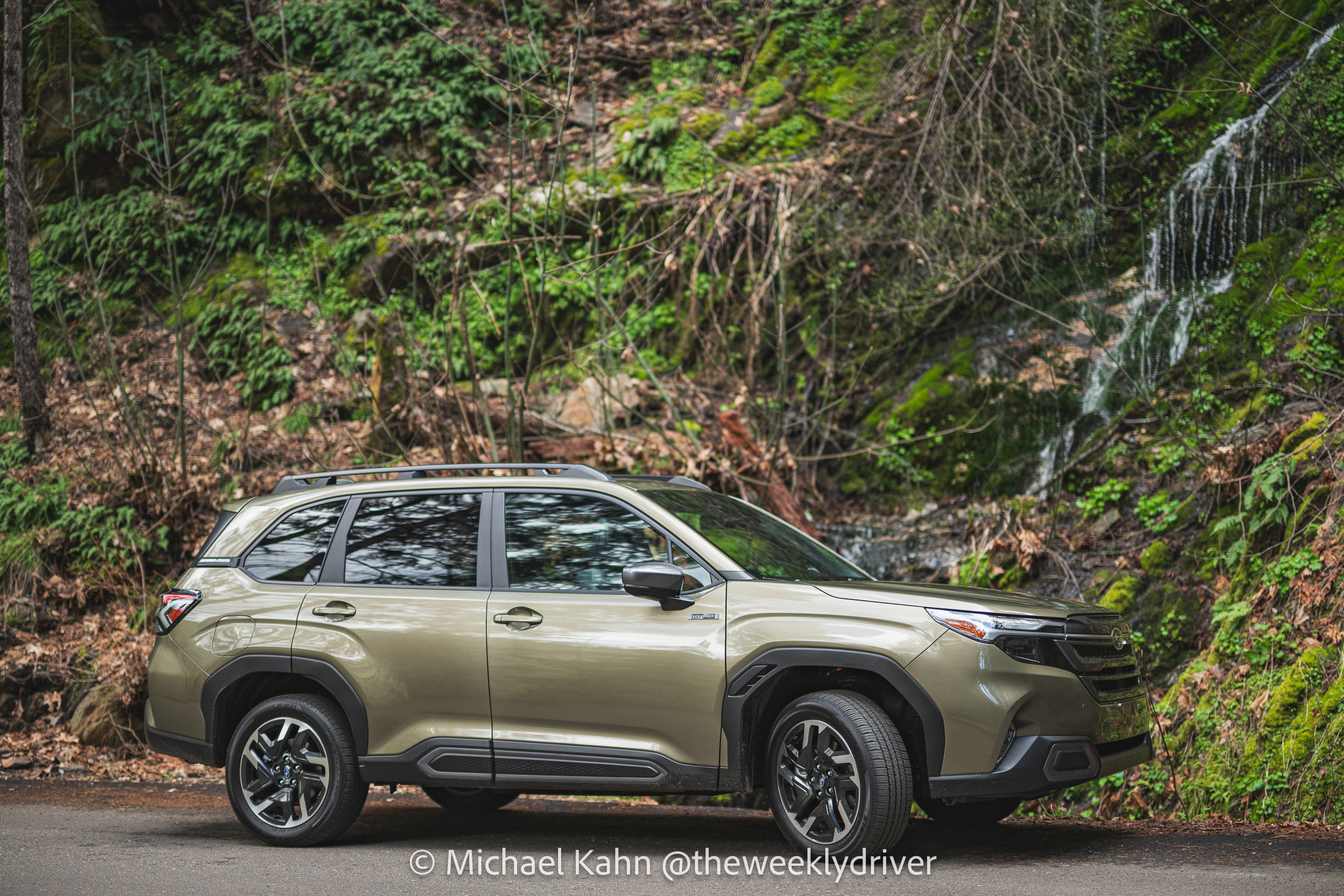
Exterior Adventure
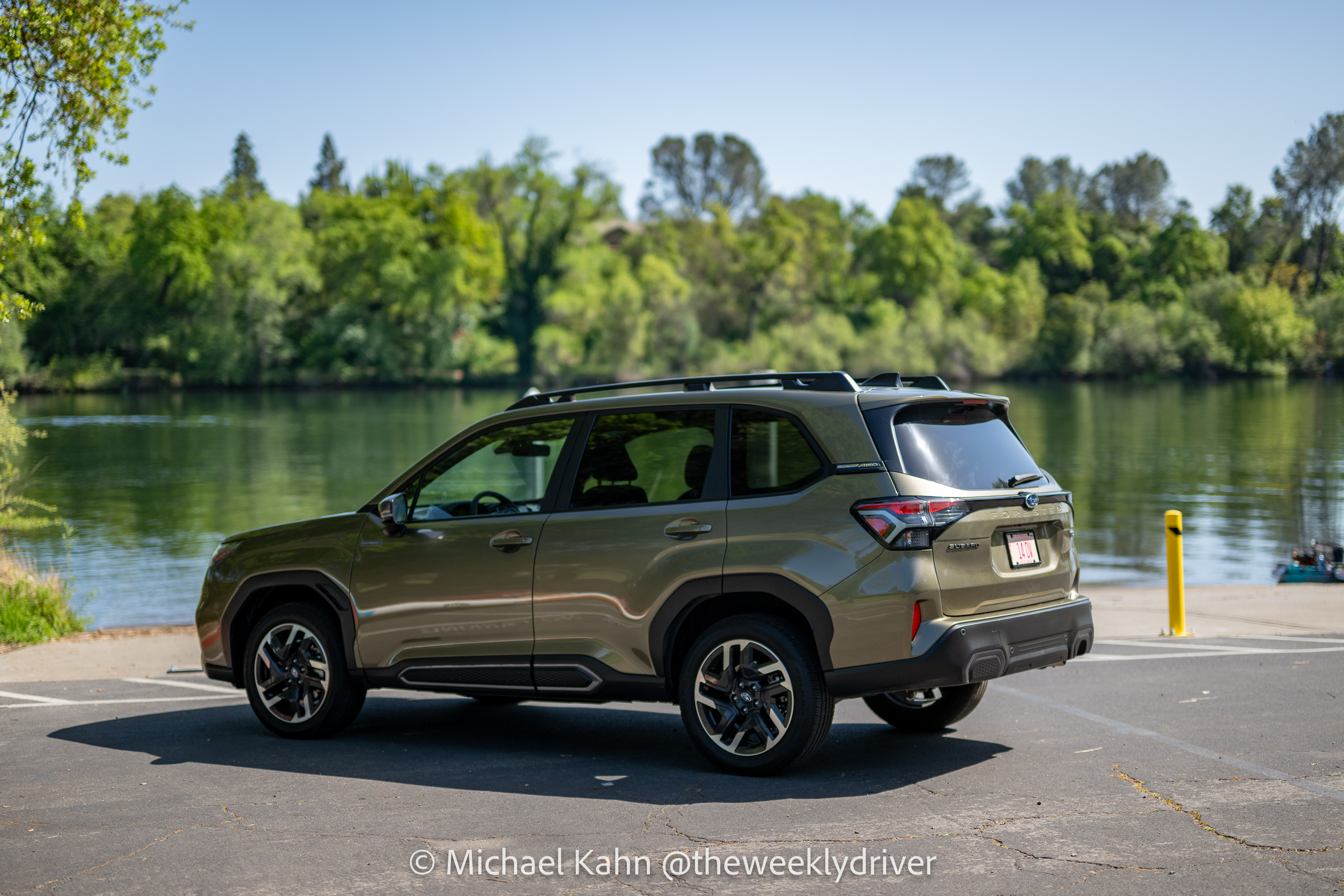
The sixth-generation Subaru Forester receives a significant redesign for 2025, and the new hybrid powertrain represents the most substantial change.
The exterior presents a cleaner, more contemporary look while preserving the practical proportions that define this nameplate.
At 183.3 inches long with a 105.1-inch wheelbase, the Forester maintains a footprint that works in tight parking lots but still delivers genuine cargo space for outdoor pursuits.
Standard roof rails make it simple to attach crossbars and a Thule paddleboard carrier, if you’re a paddle boarding fanatic like me. Two boards strap securely to the top, and the low roofline helps with loading.
The 18-inch dark metallic alloy wheels, LED fog lights with silver accents, and chrome exterior accents give the Limited Hybrid trim a refined but capable appearance.
Underguards on the bumper and sides in black with dark gray inserts signal readiness for unpaved lake access roads without resorting to aggressive off-road styling.
A stainless steel tailpipe tip adds a subtle premium touch.
Engine and Performance
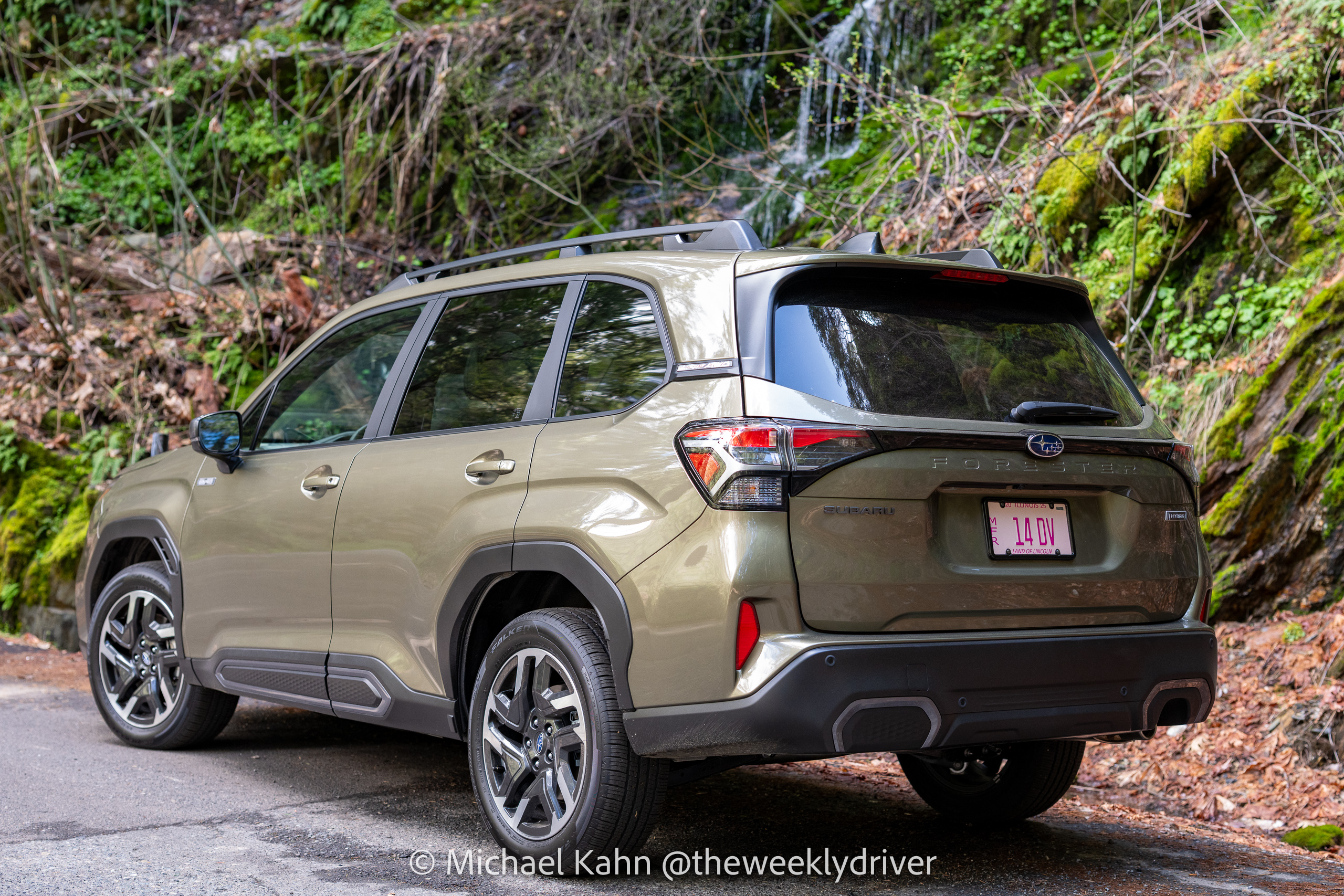
The 2025 Forester Limited Hybrid introduces an all-new next-generation series-parallel hybrid system. The powertrain combines a newly developed 2.5-liter DOHC BOXER engine optimized for Atkinson/Miller cycle operation with two electric motor generators and a high-capacity lithium-ion battery.
Total system output reaches 194 horsepower, up from 180 horsepower on the non-hybrid 2025 Forester Limited.
Power routes through a Lineartronic CVT with integrated motors, X-MODE, and a 6-speed manual shift mode.
The hybrid system uses Toyota-sourced hardware for the motor generators, but every component connects through Subaru’s mechanical Symmetrical All-Wheel Drive system.
This differs from competitors like the Honda CR-V Hybrid and Toyota RAV4 Hybrid, which route electric power through electronically controlled rear axles with front-biased torque distribution.
Acceleration improves where it matters most. The electric motor delivers instant torque from a stop, making the Forester Hybrid feel more vigorous in daily driving.
Independent testing shows 0-60 mph times around 8.6 to 9.3 seconds, which is similar to the non-hybrid model overall.
But the hybrid reaches 20, 30, and 40 mph faster due to the electric assist at low speeds. This matters more in real-world driving than the proverbial stoplight drag races.
EV Drive Mode allows pure electric operation at speeds up to 60 mph under light loads. On smooth downhill roads leading to lakes, the system engages electric-only mode with minimal noise.
The primary indication comes from the 12.3-inch digital instrument cluster displaying power flow rather than audible cues.
Active Torque Vectoring, Incline Start Assist, and Trailer Stability Assist enhance driving dynamics.
With 8.7 inches of ground clearance combined with a low step-in height, the Forester Hybrid clears rocks and ruts on unpaved lake access roads that would scrape lower crossovers.
Fuel Economy and Range
The hybrid powertrain delivers up to 40% better fuel economy than the non-hybrid model.
EPA estimates reach 35 mpg city, 34 mpg highway, and 35 mpg combined.
The 16.6-gallon fuel tank provides up to 581 miles of range on a single fill.
For weekend trips from Sacramento to Lake Tahoe or the Sierra Nevada reservoirs, the Forester Hybrid completes round trips without requiring fuel stops, with range to spare, allowing optimization on the ideal gas station detour.
Real-world mixed driving in hilly terrain with air conditioning running returned numbers close to the combined estimate.
The regenerative braking system recovers energy smoothly during descents from mountain lakes and in stop-and-go traffic. Brake pedal feel remains consistent whether engaging friction brakes or regeneration, a refinement that lesser hybrid systems struggle to achieve.
Interior and Technology
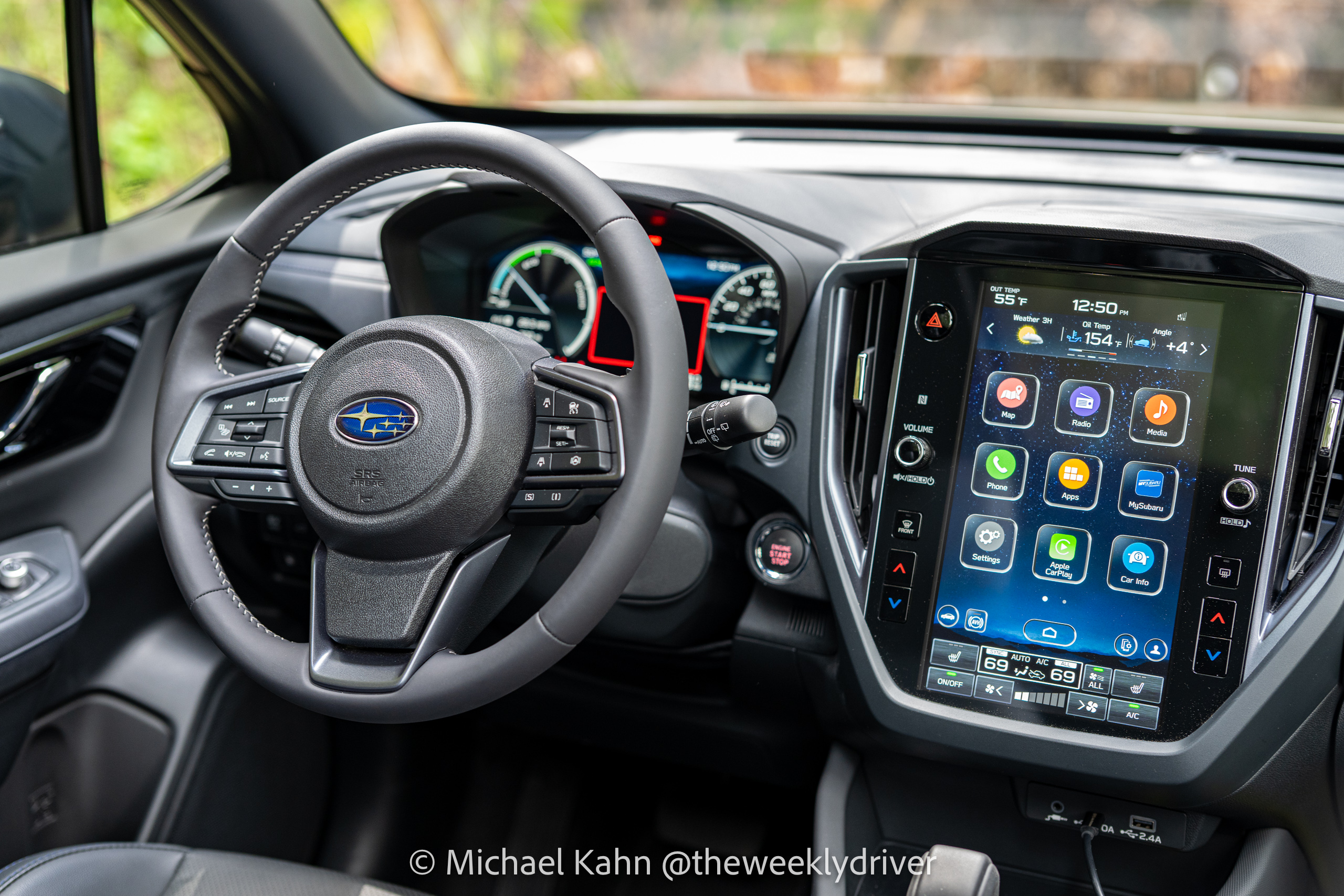
The 2025 Forester Hybrid brings meaningful improvements to cabin refinement.
The sound insulation windshield and enhanced noise deadening create a noticeably quieter interior than previous Foresters and many competitors.
Wind noise at highway speeds remains present but subdued, and the hybrid system operates with minimal intrusion. Owners consistently report the cabin feels serene during both city driving and highway cruising.
The Limited Hybrid includes Sport StarTex upholstery in gray or black with blue stitching.
This material provides leather’s appearance with easier maintenance and greater durability, ideal for returning from lake days with wet gear.
The dash panel features silver stitching, and the passenger side includes decorative trim with blue stitching and a simulated wood accent.
Chrome interior door handles add a premium feel.
A 12.3-inch full LCD digital gauge cluster display comes standard, showing navigation maps, power flow diagrams, and customizable gauges directly in front of the driver.
The 11.6-inch Subaru Starlink Multimedia Navigation system with high-resolution touchscreen handles entertainment and directions. Wireless Apple CarPlay and Android Auto eliminate cable clutter. F
or lake trips to areas without cell coverage, the built-in navigation with offline mapping capability proves valuable.
The standard Harman Kardon 11-speaker audio system with subwoofer and 576-watt equivalent amplifier fills the cabin with clear sound.
It handles everything from podcasts on long drives to music at lakeside parking areas while prepping boards and gear.
A panoramic power moonroof spans most of the roof, filling the cabin with natural light during daytime drives through forested highways. On clear nights at lakeside campgrounds, it offers views of stars without leaving the vehicle.
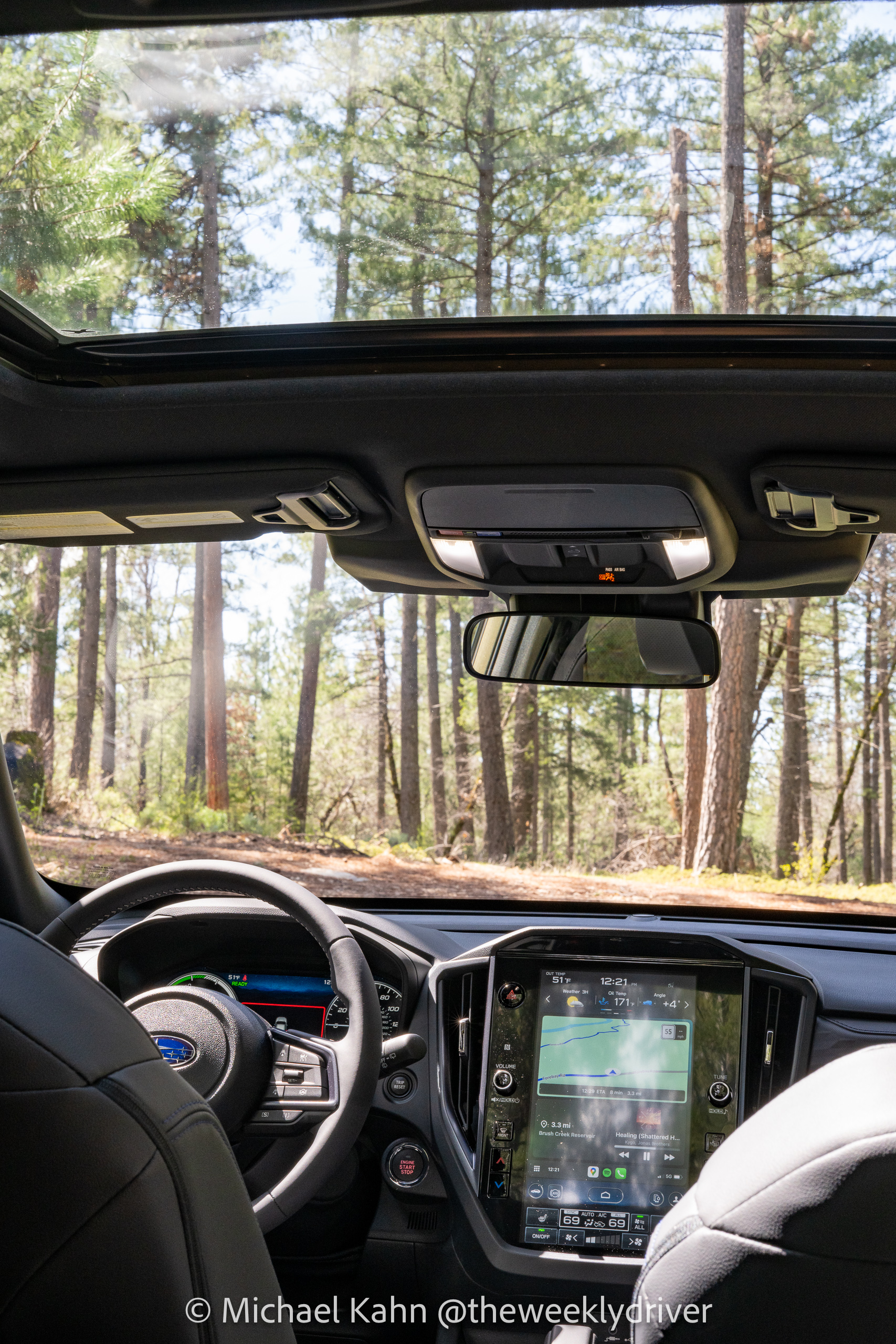
Dual-zone automatic climate control maintains comfort regardless of outside temperatures. USB-A and USB-C ports in both the front and rear center consoles keep devices charged, with illuminated rear charging ports for passengers.
A wireless charger eliminates cables for compatible phones. The 12-volt power outlets in the cargo area and center console provide additional charging options for camping equipment.
With the panoramic moonroof, cargo capacity measures 27.5 cubic feet behind the rear seats and expands to 69.1 cubic feet with the 60/40 split rear seatbacks folded.
The wider rear gate opening introduced for 2025 simplifies loading bulky items like coolers, camp chairs, and gear bags.
The power rear gate with automatic close, height memory, and hands-free foot activation sensor becomes genuinely useful when arms are full.
Approaching the rear with a paddle, accessories, and dry bag, a kick under the bumper swings the gate open. After loading, another kick closes it.
Multiple 12-foot inflatable paddle boards fit inside with the rear seats folded, useful for owners who prefer not to use roof transport. Rigid boards require roof mounting due to length.
The cargo area includes rear seatback release levers that fold seats without walking to the rear doors. This speeds up transitions when swapping between passenger and cargo configurations at the lake.
Safety Features
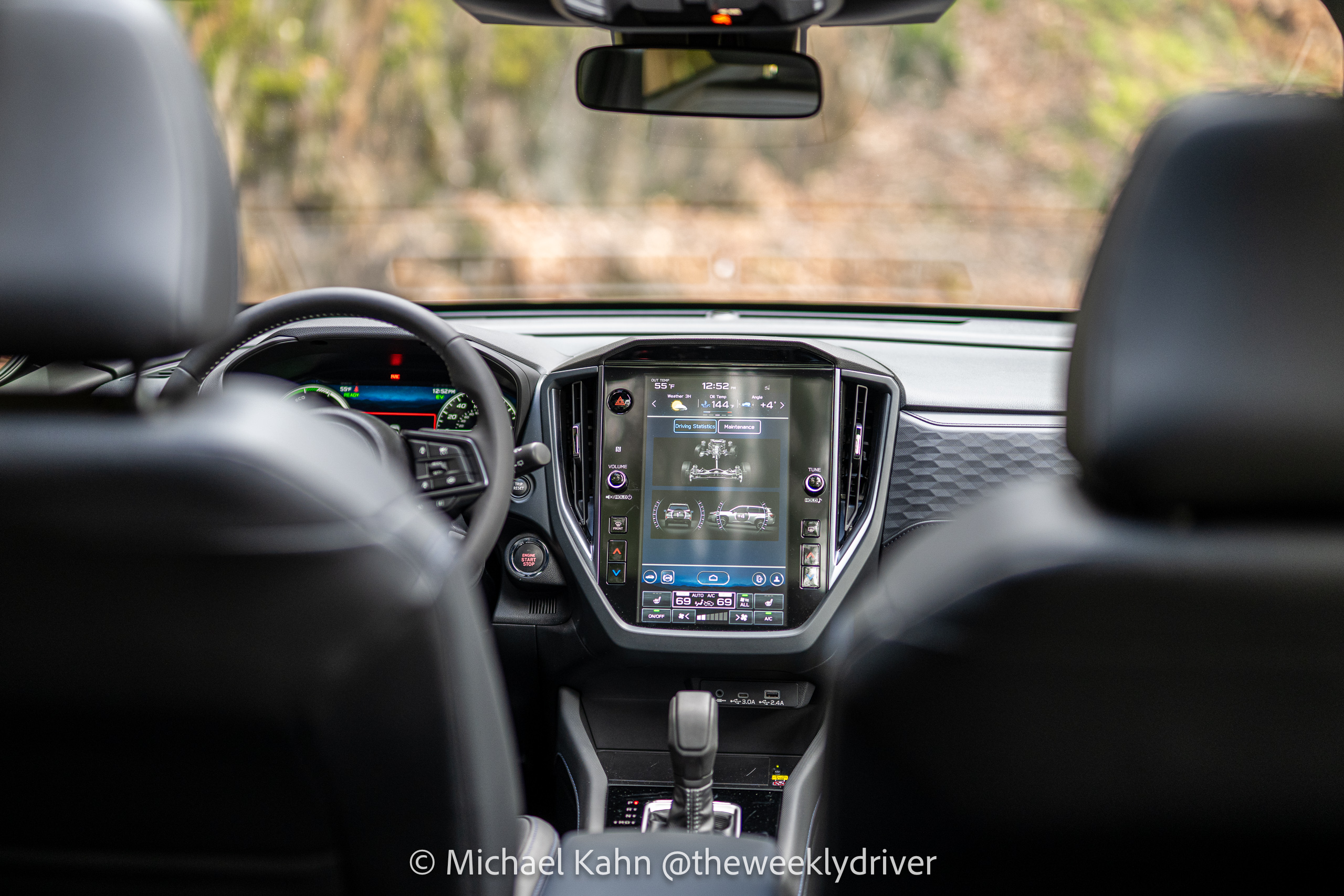
EyeSight Driver Assist Technology comes standard, featuring Advanced Adaptive Cruise Control with Lane Centering, Automatic Emergency Steering, and Pre-Collision Braking.
The Limited Hybrid adds Reverse Automatic Braking System, Blind-Spot Detection with Lane Change Assist, and Rear Cross-Traffic Alert.
During drives on winding mountain roads to backcountry lakes, Lane Centering reduced fatigue on long highway stretches.
Blind-Spot Detection proved valuable when merging on busy summer weekends. The wide-angle Rear Vision Camera helped navigate tight boat launch parking areas.
LED headlights with low and high beam, Automatic Height Adjustment, and High Beam Assist illuminate dark forest roads effectively. Headlights auto-on/off with windshield wiper operation ensures visibility during changing conditions.
Rain-sensing windshield wipers adjust automatically to precipitation.
MySubaru Safety Plus provides a 3-year free subscription, with Safety Plus and Security Plus package for 6 months free.
The system offers automatic collision notification, stolen vehicle locator, and remote engine start via smartphone. Subaru Connected Services Wi-Fi hotspot capability requires an active AT&T subscription.
Pricing
The 2025 Forester Limited Hybrid starts at $39,410. With $1,420 destination and delivery, the total comes to $40,830.
This positions the Limited Hybrid in the middle of the compact hybrid SUV segment.
The Honda CR-V Hybrid Sport Touring starts at $42,550 with 40 mpg combined but uses an electronic rear axle for AWD. The Toyota RAV4 Hybrid Limited starts at $41,715 with 39 mpg combined and similar electronic AWD. The Mazda CX-50 Hybrid Premium Plus starts at $41,995 with 38 mpg combined.
The Forester Hybrid distinguishes itself with standard mechanical all-wheel drive that routes both gasoline and electric power through all four wheels continuously, 8.7 inches of ground clearance, and Subaru’s reputation for long-term reliability.
Consumer Reports rates Subaru as the 2025 Most Reliable and Best Overall Automotive Brand.
Specifications
| Category | Specification |
|---|---|
| Powertrain | 2.5L DOHC BOXER + Two Electric Motor Generators |
| Combined Output | 194 hp |
| Transmission | Lineartronic CVT with Integrated Motors |
| Drive | Symmetrical AWD |
| Fuel Economy | 35 city / 34 hwy / 35 combined mpg |
| Fuel Tank | 16.6 gallons |
| Range | Up to 581 miles |
| Cargo Volume | 27.5 cu ft (seats up) / 69.1 cu ft (seats down) |
| Ground Clearance | 8.7 inches |
| Towing Capacity | 1,500 lbs |
| 0-60 mph | 8.6-9.3 seconds |
| Wheelbase | 105.1 inches |
| Length | 183.3 inches |
| Curb Weight | 3,911 lbs |
| Base Price | $39,410 |
| As Tested | $40,830 |
Driving Impressions Over a Week
The Forester Limited Hybrid delivers a composed, comfortable ride. The added weight from the hybrid system, approximately 300 pounds compared to the non-hybrid, actually improves stability and ride quality.
The suspension absorbs imperfections without harsh impacts while maintaining composure through corners with minimal body roll.
Steering uses a dual-pinion electric power-assisted system that provides accurate feedback with light effort appropriate for the vehicle’s mission.
Visibility from the driver’s seat remains excellent, with large windows, thin pillars, and an upright greenhouse providing clear sightlines in all directions.
This outstanding visibility is a Forester hallmark that competitors struggle to match.
The cabin stays remarkably quiet. Enhanced sound insulation minimizes wind rush on the highway, and the hybrid system operates unobtrusively whether the engine is running or the vehicle is in EV mode.
The only noticeable engine noise occurs under hard acceleration.
Braking feels consistent and predictable. The regenerative system blends seamlessly with friction brakes, providing natural pedal modulation.
Independent testing recorded 60-0 mph stops averaging 112 feet, competitive for the segment.
On a trip to Lake Clementine, the Forester Hybrid handled every aspect of the journey without complaint. The drive from the freeway to the recreation area mixed suburban traffic with stretches of gravel and washed out dirt roads near the water. X-MODE managed the loose surface, and ground clearance provided confidence over ruts and channels.
At the launch area, the foot-activated power gate opened while carrying boards and gear.
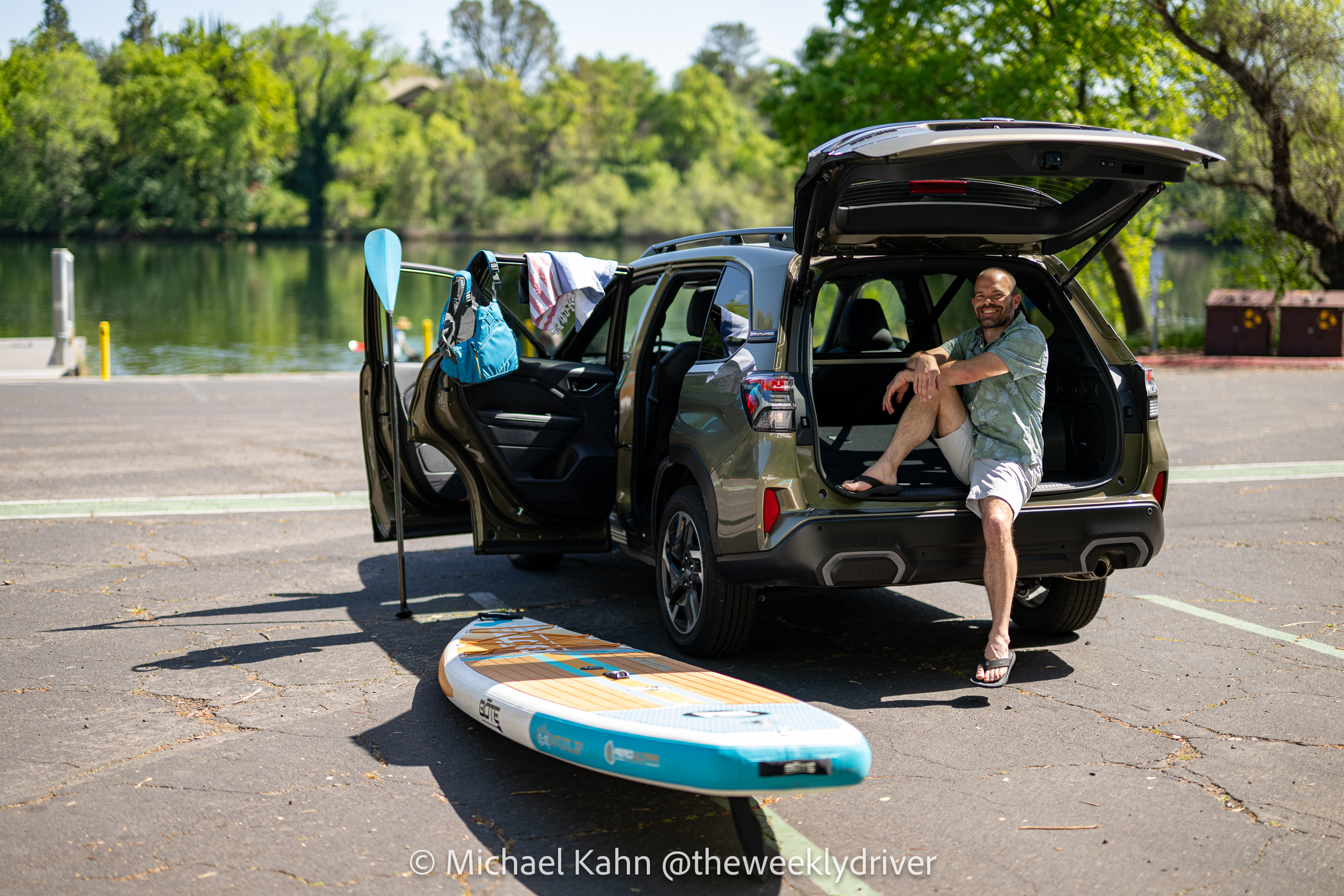
The cargo area accommodated a cooler, two PFDs, paddles, multiple dry bags with towels and sunscreen, and a small sun tent.
The Sport StarTex upholstery shrugged off wet gear without concern.
After a full day on the water, the return drive featured the Harman Kardon audio playing through Bluetooth, dual-zone climate control cooling the cabin, and the panoramic moonroof cracked open to let in fresh air.
The fuel gauge barely moved despite the round trip.
Similar trips to Fuller Lake and small reservoirs repeated the pattern.
The 581-mile range meant refueling became an afterthought rather than a planning concern.
The Forester Hybrid fits the lifestyle of owners who spend weekends on the water without requiring truck-like towing capacity or Jeep-level trail capability.
The 2025 Subaru Forester Limited Hybrid does not chase maximum fuel economy numbers or offer the quickest acceleration in the segment. It delivers something more valuable for outdoor enthusiasts: genuine capability combined with meaningful efficiency improvements.
The 581-mile range eliminates range anxiety on long weekends. The mechanical all-wheel drive system provides traction that electronic competitors cannot match on loose surfaces.
The quiet cabin and smooth hybrid operation create a relaxed driving experience. The practical cargo space and roof rail capability handle paddle boards, kayaks, and camping gear without compromise.
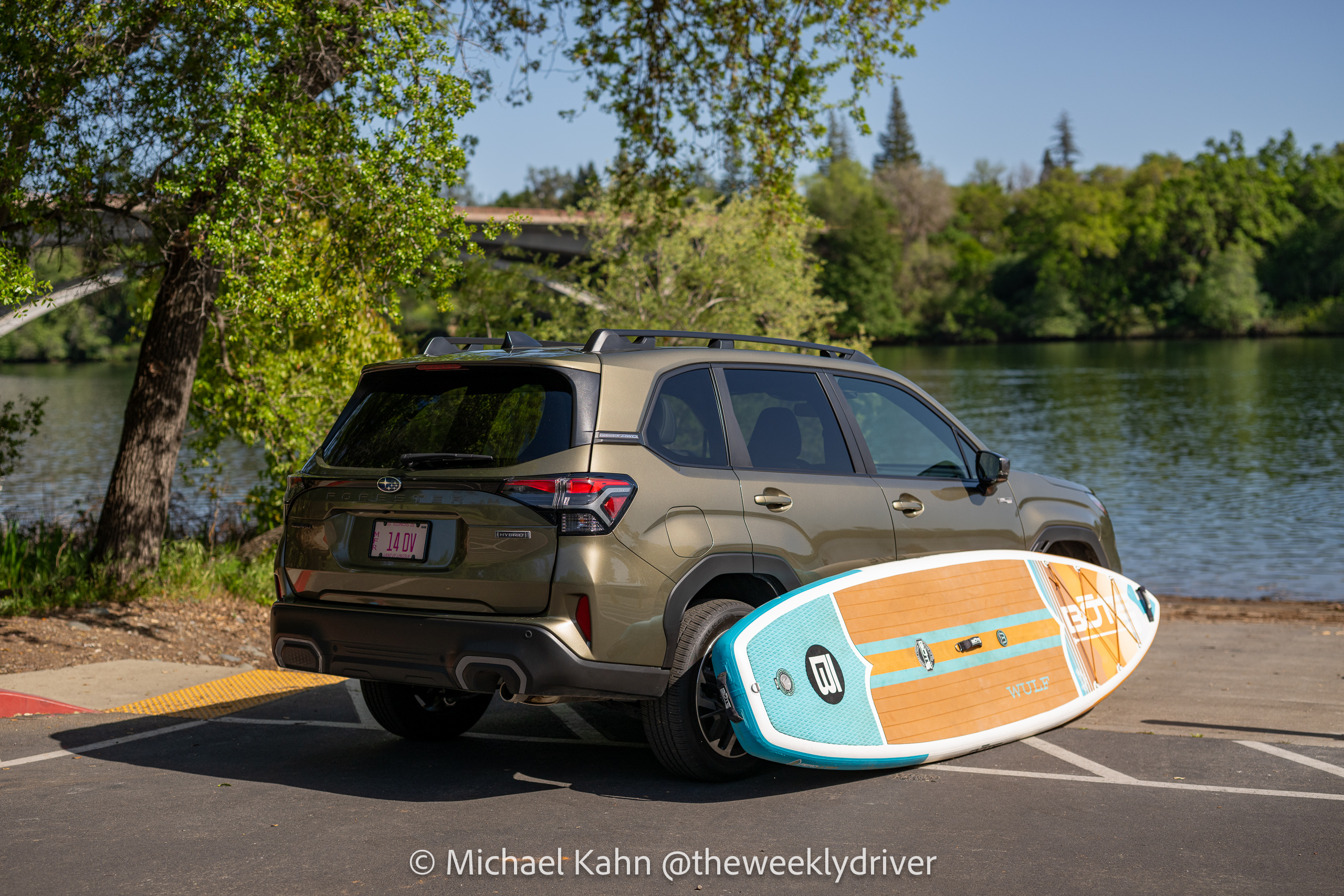
For paddle boarders, kayakers, and anyone who spends weekends at lakes and reservoirs, the Forester Hybrid handles every aspect of the journey. It carries gear securely, navigates unpaved access roads without hesitation, and returns impressive fuel economy on the drive home.
In a market obsessed with performance numbers and feature counts, the Subaru Forester Limited Hybrid proves that substance, executed thoughtfully and delivered consistently, wins every single time.
Article Last Updated: November 24, 2025.
